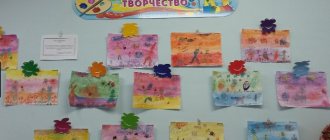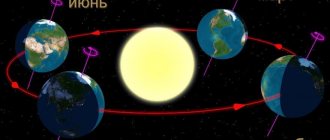Abstract of the GCD on FCCM in the preparatory group “Conversation about autumn”
The ears rose like arrows. A quiet rustle is heard:
Someone is sneaking through the forest. The bunny confuses his tracks
Runs away from trouble. He jumped to the side and turned around,
And curled up under a bush, like a little white ball,
So that no one could find it. (curls up into a ball)
Finger game “Wolf and Fox” A gray wolf runs through the forest and a fox runs after him.
They rose like a trumpet. Two fluffy tails.
Educator: September has gone, and after September came October - a gloomy, wet month. What is it called? (Falling leaves.) “In October there are seven weather conditions outside.” Why do they say this about October?
(October is a very capricious month. The weather can change several times during the day: either the sun is shining brightly, or the annoying rain is drizzling, or the first snowflakes are fluttering.)
Educator: All the signs of autumn were once noticed by people on the basis of constant observations of the life of nature. Let's remember folk signs.
Late leaf fall means a harsh, long winter.
A strong wind during rain foretells good weather in winter.
— Thunder in September foreshadows warm weather.
The web spreads over the plants - to the warmth.
The appearance of mosquitoes in late autumn means a mild winter.
Educator: If in September the birds are preparing to fly away, then in October they begin to fly away. Which birds fly away first?
Swifts and swallows, because they feed only on insects. With the onset of cold weather, insects become less and less
Educator: Which ones fly away a little later?
(Cranes, rooks and cuckoos fly away a little later, because they can willingly exchange their food for berries, fruits and grains.)
Educator: Which birds fly away last?
(The last to fly away are geese, ducks and swans, until the reservoirs freeze, they have enough food.)
Educator: What birds fly alone? (Cuckoo, falcon.) All birds fly away in different ways. How do cranes fly? (With a wedge). Ducks? (Straight front) Geese? (In a jamb).
Let’s say goodbye to them and say “thank you” to them for their beautiful and joyful songs, for protecting the trees from pests, for helping us dream of flying when rising into the sky.
Birds that fly to warmer climes, as we call them? (Migratory.)
Educator: Birds that winter with us? (Winterers.) People call them “winterers.” And we must take care of them. What is our concern? (We can make feeders and feed our feathered friends)
Educator: What do people do in October?
(Mushroom pickers wander through the forests in the hope that a late mushroom will be found. “If a late fungus appears, there will be a late snow.” People collect the remaining harvest from fields and vegetable gardens. Housewives chop and ferment cabbage in October. It’s not for nothing that people say: “September smelled like apples mi, and October - cabbage.")
Summary of an open lesson on FCCM in the preparatory group “Mathematical tournament”
Lesson topic:
"Math Tournament"
Target
: determining the quality of children’s mastery of the level of mathematical development in competition conditions
Tasks:
- teach children to apply acquired knowledge in fun, non-standard tasks;
- develop intelligence, attention, speed of reaction, resourcefulness;
- cultivate cognitive interest in mathematics and self-confidence;
Type of lesson:
consolidation of knowledge and methods of activity using modern gaming technologies.
Progress of the lesson:
1 part. Organizational stage.
Teacher: -
You guys are funny
And you don’t like to be bored
With pleasure today
Let's play a math tournament!
— Today you will take an unusual journey into the world of curious tasks, riddles, and questions. Your ingenuity, resourcefulness, ingenuity, competition and mutual assistance will help you with this. What do you need to do to find out who will compete on which team? (children's answers).
That's right, you need to divide into teams using tokens.
Division into teams.
Teacher: -
Today we have two teams that will perform mathematical tasks. These are the “Know-It-All” and “Know-It-All” teams.
Both teams love to play, want to know everything in the world and, of course, win. Let's develop the rules of our tournament. I will voice these rules, if you agree with me, then clap your hands.
- Play fair;
- It's a shame when you lose, but don't get angry;
- Don't gloat when others lose;
- If you win, rejoice, but don’t become arrogant;
- Be calm, do not be discouraged by failures;
Part 2. Main stage.
- Competition – warm-up: “Exercise for the mind.”
Assignment for teams:
"Znayki"
"Know-It-Alls"
- Tanya is taller than Lena, Lena is taller than Dasha. Who is tallest? (Tanya)
- The animal has 2 left legs, 2 right legs, 2 more in front of the legs, 2 in the back. How many legs do animals have? (4)
- How many days in a week, including weekends? (7, 2)
- Petya, Ira, Yura, Misha, Tanya were walking on the street. How many boys were there? Volodya came. How many children are there? (3
and 6
)
- Petya is smarter than Misha, Kolya is smarter than Petya, therefore the smartest (Kolya)
- How many front and back legs does a duck have? (2)
- How many seasons and winter months are there in a year? (4 and 3)
- 2 sons rode a tricycle, and their father rode a two-wheeler. How many wheels were there in total? (8)
For each correct answer - a token.
- Competition - game: "Find the mistake."
One card per team. For example, to the “Knowledge” team: 10 13 14 15 16 17 18.19 20; Team “Know-It-All”: 10 11 12 13 15 16 18, 19 20;
3. Competition - game: “Number Neighbors”.
Each team has 2 cards on the table, turned down, showing the numbers of the second ten.
One of the team members selects a card, turns it over, names the number, and the team names the “neighbors” of the dropped number. If someone fails or makes a mistake, the other team helps and earns extra points.





